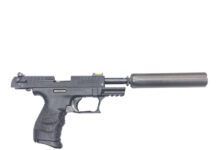All Mossberg autoloaders available are gas operated. Each bleeds a set amount of gas from the ignition of the shotshell, down through a port in the barrel to function the action.
The oldest of these guns, the Model 5500, requires the shooter to change barrels when switching from non-Magnum to Magnum loads. Two updated 5500s—the new Model 6000 and the Maverick 60—will continue to do so. A totally new Mossberg, the Model 9200, allows free interchange of ammunition without changing barrels.
The differences between the 6000, 60, and 9200 lie forward of the breech where the barrel joins the foreend, and in the barrels themselves. The 9200 employs a gas metering (compensating) valve to achieve load flexibility. The 6000 and 60, like the 5500, have no compensator. The size of the port determines the type of ammunition to which an individual barrel is dedicated—a larger port for standard loads, a smaller one for Magnums.
There are some significant differences between the newer Mossbergs and the 5500, primarily in the trigger mechanism and the bolt release, but basic troubleshooting remains much the same for all. In taking you through it, I’ll concentrate on the 5500, and point out where some of the problems that can occur have been eliminated by design changes in the new guns.If you are facing your first Mossberg, compare an exploded drawing and parts list of it to those of another manufacturer’s autoloader. An “elevator” to Mossberg is a “carrier” elsewhere, and all parts associated with them are similarly, dissimilarly labeled.
Common Problems And Solutions
Like all autoloaders, a Mossberg will refuse to work when its insides are full of gunk. Pull the bolt back slowly. If it feels gummy or mushy on the way back, you’ll know there is at least a good cleaning job ahead. Now remove the foreend and examine the gas cylinder. Is the O-ring missing? If so, it could be the cause, but keep going. Is the inner seal ring on with its beveled edge resting against the inertia weight? Is the double end of the recoil spring positioned toward the receiver? If the answer is “no” to either of the above, it’s a cause for failures to eject. Next, check the relationship of the slots on the outer and inner piston rings. They should be positioned 180 degrees apart to properly seal against gas escaping from the forward end of the cylinder instead of functioning the firearm.
Check out the action bar. Does it move smoothly in its receiver slots, or does it bind? If it’s binding, it could throw the timing off, causing ejection failures. Maybe it’s been squeezed or bent. If you can’t straighten or spread it back open easily, replace it. Another cause of an action binding is burrs. Whether they are on the action bar itself or in its slots, stone them out. By the way, actions that bind also relate to failures to lock open.
Sometimes overlooked as a source for ejection failures is the barrel’s gas port. If it is fouled, there is no way the gun can get past the first round. Use a small, stiff piece of wire to poke out the dirt. If a port is packed too solidly for the wire to clear it, a mini-drill bit—a number 54 or less—rotated between the thumb and forefinger can be used to ream out the crud without damage to the port. Never enlarge a gas port in the cleaning process, and it is a good idea to look for signs that it has been messed with in the past by persons unknown who figured bigger would result in better performance. Actually, what results is severe internal stress that can destroy a receiver.
With Mossbergs, the ejector pin is an integral part of the barrel extension. It’s a triangular nub that has been known to break, requiring a new barrel or the factory fitting of a new pin. Check it out. After that, examine the chamber and the extractor.
The chamber may have become roughened through abuse or poor maintenance, causing a fired shell to stick. If it looks beat up, polish it out. I use a Flex Hone chucked into a variable speed hand drill, run at low speed with Flex Hone lubricant, and recommend it highly over a bronze brush or the finest of steel wool.
The extractor may not be free enough in its slots to grab the shell. Use your thumb to push it away from the bolt face and let it snap back in place. If it feels sluggish, depress the plunger located behind the extractor in the bolt’s extractor slot, hold it down, and pivot out the extractor. Examine the piece and the slot for burrs or nicks. Stone them if they’re minor, but if the extractor hook has been damaged to the point where smoothing it up will alter angles, trash it and fit a new extractor. In the process, take a look at the extractor spring; it might also need replacing.
Feeding and Other Problems
A damaged magazine tube, follower, or spring can cause failures to feed. If the blame lies with the follower or spring, either is easily replaced by popping out the retainer at the front of the tube. Just remember to restrain the spring by keeping your thumb over the tube’s end.
If the magazine tube is at fault, you need to make or purchase tooling to remove and repair or replace it. A block of wood, faced with leather pads and made to fit into the receiver from the bottom, will serve if you decide to manufacture your own. Easier, and less time consuming, is the wrench used at Mossberg’s Armorer’s School and sold by Brownells. Whatever your choice, turn the receiver upside down, lock the tube’s front inch into padded vise jaws, insert the wrench, and turn the receiver counterclockwise. The tube may be epoxied in, so don’t apply too much force. You might be able to free up the threads by applying gentle heat to the tube’s back end. If that doesn’t work, have the factory make the repair. It beats giving yourself a bad name by springing a receiver.
Older 5500s have a straight elevator which presents the shotshell to the barrel’s breech at a steep angle. In such guns, the bolt has been known to slam the shell into the barrel’s face and jam it there. A redesigned 5500 elevator has a bevel that cants the shell down, presents it centerbore and eliminates the problem. If you come across one of the older elevators, replace it with a newly designed one. They’re available from the factory’s service department. I doubt you will find a straight elevator in a 5500 of recent manufacture, and I’m certain you won’t in the 6000, the 60, or 9200.
The right hand latch, or magazine catch, retains the shell in the tube until it is to be released to the elevator and carried up for feeding into the chamber. If the end of the latch is bent too far to the outside of the shell’s rim, or too far inside, it will fail to release it onto the elevator, jamming the mechanism. Check out the latch’s end with a dummy round, figuring an intrusion of .050 inch from the case rim as just about ideal; less than .020 inch is not enough engagement, and more than .100 inch is too much.
Let’s assume you have discovered a latch that has been damaged and is going to need some tweaking to get it back to specs. You get it out by laying the receiver on its side with the trigger-housing opening facing you. There are two holes on each side of the opening that house grooved pins held in receiver slots by hairpin clips. Push in on the shell latch and hold it in. Use a paper clip or dental pick to disengage the hairpin clip toward the back of the receiver, and remove it from its slot. With the same tool, work your way up inside the receiver, push the two grooved pins down, then remove them and the latch.
The latch itself is spring steel. To bend it, you’ll have to anneal and then re-temper it. It sounds simple, but if you lack the equipment and experience, replace the damaged part rather than trying to fix it. Failure to properly restore the temper will result in a latch that is in worse shape than it used to be—all because of you.
Whether you repair or replace it, when you reinstall the latch, make sure the hairpin clip goes in its slot flat side down and open end facing forward. Otherwise, the clip will work loose due to recoil and the gun won’t function. Incidentally, the right latches on 5500s used to have a 45-degree angle tab on their ends. Once in a while, these latches interfered with the bolt’s slamming shut. The factory changed the angle to 30 degrees and the problem disappeared. If the latch you take out has a 45-degree angle, replace it with the new model. In this case, less is better.
As for the left shell stop, remove it the same way as the right, but it is probably not necessary unless you need to replace it or its spring. Left stop springs on the 5500 serve a lesser purpose than those on a Model 6000, Maverick 60, or Model 9200. The 5500 releases the bolt the old fashioned way, via upward pressure on the elevator. The newer guns have a bolt-release button on their right sides and thus a bigger, stronger spring.
The Trigger Assembly
For reasons of liability, the factory prefers to perform all repairs on trigger mechanisms itself or have them performed at an authorized Mossberg service center. Parts do break, though, and you can replace those that aren’t restricted. So, here’s how to disassemble the 5500’s trigger assembly. The step-by-step instructions can’t be found in any other publication I’ve seen and, while there are differences I’ll note, the same rules apply to the 6000, 60, and 9200 as well.
Remove the elevator bushing, elevator, elevator pawl, pawl strut, and pawl spring. Note that the 5500’s latch has an elevator lock-up tab on it and that its pawl strut is straight. The 6000, 60, and 9200 have a flat latch and an arced pawl strut. There’s a reason: The elevator of the 5500 locks up on the latch, while the elevators of the other three guns lock up on the shell stop itself. In this new design, all the energy required to move the right-hand latch is dedicated to moving only it, and a more positive release from the magazine is achieved.
Now release the tension on the hammer, remove the combination elevator latch/hammer pin, and then the hammer itself. Remove the hammer-spring ferrule, elevator-latch spring, and elevator-latch plunger in that order. The rear bushing is next, followed by the sear pin, disconnector spring, trigger pin, and trigger. (The disconnector and trigger are held together by a single pin which is not staked in. This pin is easily lost and shouldn’t be removed unless a replacement is necessary.)
Reassembly Tips
After dropping the trigger in, push it forward to line up the holes before inserting the trigger pin from left to right. Pull back on the disconnector, holding it back when reinstalling the disconnector spring, and making sure the tight end of the spring fits over the tab on the sear. The countersunk side of the pawl should face toward the inside of the elevator. The elevator bushing goes in right to left, and the rear bushing left to right. Their C-clips must be on the same sides of the trigger assembly as they were when you removed them, or the housing won’t fit back into the receiver.
Once you’ve learned the 5500, you should have no trouble servicing the 6000, 60, or 9200. The reverse is also true. And, for those interested in becoming a Mossberg Authorized Service Center, the only way you can achieve that these days is to attend their Police Armorer’s School. Due to liability lawsuits, things aren’t as easy as they used to be.




















Great info – that you! How do I replace a bolt buffer in a 9200? I removed the trigger assembly and a plastic fragments fell out of the receiver…. Not sure how it looks when replaced.
John